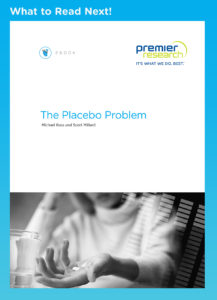The placebo response is a real psychological, physiological, and ultimately statistical phenomenon that can be a powerful therapeutic tool in the world of medicine, especially when it comes to chronic pain conditions. For a drug to be approved, its developers must be able to demonstrate that it is significantly more effective compared to a placebo. Unfortunately, placebo response rates and effect sizes have increased considerably over the last few decades. Even certain well-established drugs can no longer surpass placebos in modern trials. This trend threatens the approval of legitimate drugs in the future.
Consequently, successful clinical trials must be able to accurately measure and mitigate placebo responses. But how do researchers quantify such a diverse range of phenomena? Read on for an overview.
Experimental Designs
A fundamental aspect of clinical trials is that the ability to measure the placebo effect is “baked into” successful experimental design. And — like clinical research in general — there is no one-size-fits-all approach to study design. Each design has its own drawbacks and benefits.
Treatment Arms
Selecting which treatment arms to include in your study is a basic part of assessing placebo effects. Although not always feasible, a study design that incorporates active, placebo, and no treatment arms can directly determine placebo effect size. In these trials, the size of placebo response can be defined as the difference between placebo and no treatment arms. This methodology is great for early research studies, but it is not ideal for large Phase III trials.
Crossover Design
In a crossover design, each patient is initially treated with either the test drug or a placebo. At a predetermined time point, these groups “cross over” into the other. Using this method, patients serve as their own control. Patients also benefit from this type of study design in that each receives some form of active treatment over the course of the study. However, crossover design does have its own limiting issues, mostly because of the fact that patients and subsequent treatments react to the previous phase. For example, patients who received active treatment during the first phase may exhibit a higher placebo response in anticipation of continued improvement. Likewise, patients who were initially in the placebo group may have lower expectations during the active drug phase, reducing reported effectiveness.
Response Conditioning
Verbal cues and instructions can be used to condition patients to have a stronger placebo — or even nocebo — response. By carefully planning out clinician–patient interactions and dialogs, clever study design can help control for the placebo response in clinical trials.
Pharmacological Conditioning
In pharmacological conditioning, patients are conditioned with a drug in combination with verbal and nonverbal cues.
Understanding Drug–Placebo Interactions
Three possible ways that drugs and placebo effects interact include:
Additive
In an additive interaction, the overall response is equal to the drug response plus the placebo response.
Interactive
Interactive interactions represent the interplay between both the placebo response and active drugs. This often leads to unequal placebo responses between the drug and placebo groups.
Fixed Maximum Response
In these conditions, researchers assume that there is a fixed maximum response, meaning that there is a maximum overall response for each patient. Consequently, when the placebo response increases, that difference comes at the expense of the treatment response. If the best that can be achieved is a 60% improvement, then nothing greater than that will be observed. When the placebo response isn’t properly managed, the difference between placebo and treatment groups may not be big enough to gain market approval.
Trial-Independent Factors
There are two factors that affect chronic pain trials regardless of patient population, study design, or drug being tested. These are:
1. Regression to the mean — This is a phenomenon that can be very damaging to clinical trials. Random error results in variability over time. When a patient’s early measurements happen to be higher than average, their symptoms will appear to improve over time as subsequent values are closer to their mean. When such patients are in the placebo group, the placebo effect size will be high. Additionally, this generally does not happen in reverse (i.e., the patient appears to get worse over time) because patients with low-severity pain are screened out.
2. Tendency of patients to get better over time — Chronic pain tends to wax and wain. This means that what looks like improvement over the course of the study for a patient with an initially high pain score may just be where they would have been without intervention. Because of this factor and regression to the mean, patients who are outliers with either very high or very low pain scores should be screened out early.
How Can We Use This Information?
Luckily, there are both study design and patient selection approaches for mitigating the placebo response. We’ll be taking a look at ways in which drug developers can reduce the impact of the placebo effect in their studies.

